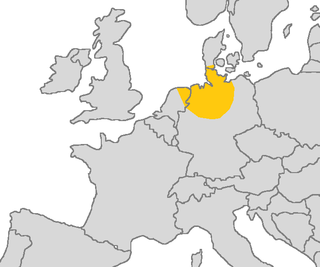
Back Ealdseaxisc sprǣc ANG Saxón antiguu AST Старажытнасаксонская мова Byelorussian Gammelsaksisk (sprog) Danish Altsächsische Sprache German Malnovsaksa lingvo Esperanto Sajón antiguo Spanish ساکسونی باستان Persian Muinaissaksi Finnish Vieux saxon French
| Old Saxon | |
|---|---|
| Old Low German | |
| Sahsisk | |
| Region | Northwest Germany, Northeast Netherlands, Southern Denmark (North Schleswig) |
| Ethnicity | Saxons |
| Era | 8th–12th centuries; mostly developed into Middle Low German at the end of the 12th century |
| Runic[citation needed], later Latin | |
| Language codes | |
| ISO 639-3 | osx |
osx | |
| Glottolog | olds1250 |
 Area in which Old Saxon was spoken in yellow | |
Old Saxon (German: altsächsische Sprache), also known as Old Low German (German: altniederdeutsche Sprache), was a Germanic language and the earliest recorded form of Low German (spoken nowadays in Northern Germany, the northeastern Netherlands, southern Denmark, the Americas and parts of Eastern Europe). It is a West Germanic language, closely related to the Anglo-Frisian languages.[1] It is documented from the 8th century until the 12th century, when it gradually evolved into Middle Low German. It was spoken throughout modern northwestern Germany, primarily in the coastal regions and in the eastern Netherlands by Saxons, a Germanic tribe that inhabited the region of Saxony. It partially shares Anglo-Frisian's (Old Frisian, Old English) Ingvaeonic nasal spirant law which sets it apart from Low Franconian and Irminonic languages, such as Dutch, Luxembourgish and German.
The grammar of Old Saxon was fully inflected with five grammatical cases (nominative, accusative, genitive, dative, and instrumental), three grammatical numbers (singular, plural, and dual), and three grammatical genders (masculine, feminine, and neuter). The dual forms occurred in the first and second persons only.
- ^ Britannica 2024, Old Saxon language.